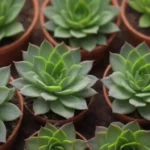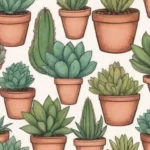
Combining Indoor Succulents with Other Houseplants for Unique Looks

Introduction
In recent years, the trend of incorporating indoor succulents into home décor has grown exponentially. Their remarkable ability to thrive in varying environmental conditions, paired with their captivating shapes and colors, makes them a favored choice among plant enthusiasts. However, the allure of succulents goes beyond their individual aesthetic appeal. When combined with other houseplants, succulents can create stunning visual displays that showcase a variety of textures, colors, and forms, enhancing the overall ambiance of living spaces.
This article will explore the art of combining indoor succulents with various types of houseplants, focusing on how these combinations can yield unique looks that brighten and elevate home environments. We will delve into tips and techniques for successful arrangements, suggest plant pairings, discuss care considerations, and highlight the key benefits of blending different plants.
Understanding the Basics of Plant Pairing
When it comes to creating a visually appealing indoor garden, plant pairing is not merely about aesthetics; it’s also about understanding the individual care needs of each plant. Succulents are unique in that they are drought-resistant, typically requiring less water, making them adaptable to a variety of conditions. However, this means that choosing compatible plants is crucial to avoid issues such as overwatering or insufficient sunlight.
Choosing Complementary Plants
One of the most important aspects of combining succulents with other houseplants is ensuring that you select plants that can thrive in similar conditions. Tropical plants, such as peace lilies or Pothos, tend to prefer a more humid environment and often require more water than succulents. However, layering succulents with plants that have similar care needs can create a harmonious look.
When pairing plants, consider both texture and color. For example, pairing Echeveria succulents, which usually feature rosette shapes and vibrant colors, can be outstanding alongside plants with glossy leaves, like Snake plants or ZZ plants. These provide a beautiful contrast, creating a sensory experience that draws the eye. Grouping plants with contrasting but complementary foliage colors can make arrangements more visually appealing, enhancing the overall atmosphere of your space.
Understanding Growth Patterns
Another critical factor in plant pairing is understanding growth patterns. Succulents tend to have slower growth rates compared to many other houseplants. Hence, it is prudent to select plants that won’t overshadow your succulent or compete for the same space. For instance, fiddle-leaf figs or rubber plants can be magnificent companions when positioned in an ideal manner to allow sufficient light to reach the succulents planted below. Layering taller plants with shorter, compact succulents can create a stunning visual depth in your indoor garden.
Arrangement Techniques for Indoor Succulent Combinations
Successfully combining succulents with other houseplants also hinges on employing clever arrangement techniques. There's a wide variety of methods that can help create visually attractive displays in pots, terrariums, shelves, or other designated plant areas.
 A Beginner’s Guide to Indoor Succulent Watering Frequency
A Beginner’s Guide to Indoor Succulent Watering FrequencyCreating Multi-Layered Displays
To achieve depth in your arrangements, consider using multi-layered displays. You can elevate larger houseplants on pedestals or hanging planters to allow smaller succulents to shine at lower levels. This vertical approach creates a more dynamic visual display. Additionally, using varying container styles such as ceramic pots, glass terrariums, or even wooden crates can enhance the aesthetics further.
Moreover, consider creating a themed arrangement based on colors or shapes. For example, if you choose pastel-colored succulents like Hens and Chicks, pair them with light-hued foliage such as baby tears or air plants. Alternatively, grouping succulents with sharp, angular shapes with round-leafed plants can create a striking visual contrast.
Using Textured Elements for Optimum Effect
The textural component is essential in plant arrangements. For instance, the contrasting textures between the soft, rounded forms of Jade plants and the spiky leaves of Aloe Vera can create a rich, layered look. Complementing these with the smooth leaves of plants like Serissa or Ficus elevates the sensory experience.
Adding decorative pieces, like rocks, crystals, or even artistic figurines among the plants can serve to break up space while enhancing the overall look. Just be sure to leave enough space around your succulents to prevent competition for light and air circulation, essential for their health.
Care Considerations When Combining Plants

When combining succulents with other houseplants, special attention must be given to their care requirements and compatibility. This ensures not only the longevity of the plants involved but also the continuous enjoyment of the unique arrangements.
Providing the Right Environment
Creating an ideal environment for your plant combinations is crucial. Most succulents thrive in bright, indirect sunlight; hence, placing them together with plants that also prefer a similar lighting condition is advantageous. Be mindful, however, that some foliage plants might prefer brighter light than others, so conducting a bit of research to understand the light needs of all plants is advisable.
 Understanding Indoor Succulents: Basic Care and Maintenance Tips
Understanding Indoor Succulents: Basic Care and Maintenance TipsRegular watering schedules will also need to be adapted based on the plants in your arrangement. Maintain a well-draining soil to prevent water retention, which is particularly vital for succulent health. This will help prevent root rot—a common problem when different watering needs aren't properly addressed. Using pots with drainage holes allows excess water to escape and allows for checking soil moisture levels.
Monitoring Soil and Nutrient Needs
Covering the nutritional needs of your plants should also be a priority. Succulents typically require a specially formulated cactus soil mix that allows for substantial drainage. In contrast, many leafy houseplants fare better in nutrient-rich potting soil with a higher organic content. If the two types of soil are used within the same planter, it can promote uneven growth rates and nutrient uptake issues.
Consider also utilizing organic fertilizers for both kinds. For example, using a diluted balanced fertilizer may be beneficial for the foliage plants while focusing on low-nitrogen amendments for the succulents solely. Regular monitoring of plant health helps you tailor these needs more closely for a lush arrangement.
Conclusion
In conclusion, combining indoor succulents with other houseplants opens up a world of creative possibilities, allowing plant lovers to express their personality while also beautifying their living spaces. The art of arrangement can transform even the simplest plant collection into an eye-catching display that elevates home decor. From understanding the basic principles of plant pairing and arrangement techniques to considering care requirements, each element contributes to the overall success of these indoor gardens.
Exploring combinations of diverse textures, colors, and shapes is not only enjoyable but serves as an opportunity for continuous learning about plants and their ecosystems. As you embark on this journey of creativity, remain patient and attentive to the needs of each plant, and you will find satisfaction in both the care process and the final outcome of your indoor gardens.
Whether you’re a seasoned plant parent or just beginning your journey with houseplants, experimenting with new combinations can lead to exciting results that both encourage growth and delight the senses. Happy gardening!
 Indigenous Indoor Succulents to Consider for Your Home Decor
Indigenous Indoor Succulents to Consider for Your Home DecorIf you want to read more articles similar to Combining Indoor Succulents with Other Houseplants for Unique Looks, you can visit the Indoor succulents category.



You Must Read